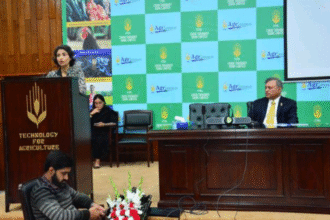
ALLAH BAKHSH GULSHAN
GHAZI UNIVERSITY DERA GHAZI KHAN,
EMAIL ID: abgulshan12@gmail.com
In the present time the climate change is one of the most unrelenting issues of the globe as well as the Pakistan. The fluctuating environment on the part of biosphere is directly affecting the life of organism including man health and economy too. The continuous changing of micro and macro factors of environment is also affecting the food security. Food safety is a big problem in the prevailing situation across the globe.
The climatic as well as the edaphic factors is deteriorating due to spreading of urbanization and industrialization without addressing the international safety measures. The availability of two vital substances for life i.e clean water and air are becoming rare day by day. Moreover. the extreme fluctuating weather of the area and changing the level of precipitation pattern is directly or indirectly effects on the life of biosphere. The increasing temperatures and other climatic measures are altering the prevalence and distribution of foodborne pathogens and toxins, posing significant risks to human health.
The International Community observed the World Food Safety Day, annually on 7th June and this day serves as a crucial reminder of the importance of safe food practices in safeguarding public health. The aims to celebrate this day actually to draw the attention and inspire action to prevent, detect, manage the foodborne risks and emphasizing the role of food safety in ensuring human health, economic prosperity, agriculture, market access, tourism, and sustainable development. The United Nations General Assembly established World Food Safety Day in 2018, recognizing the critical significance of food safety and the need for coordinated international action. The stunning statistics about illness of foodborne on this planet to highlight the urgency of this issue for the attention of internal community.
Approximately it is estimated that the 600 million people fall ill and more than four lacs die annually due to consuming contaminated food items. Children under five are disproportionately affected, carrying forty percent of the foodborne disease burden, with more than one lac deaths each year. The environmental experts are well aware and noted the newly development of the environmental changes in the region and these changes create more complications for food safety due to altering the prevalence and distribution of foodborne pathogens and toxins in the surroundings. Now, it is the time to combat these challenges and it is essential to adopt a multi-faceted approaches i.e strengthening the national food safety systems, promoting good agricultural practices, and supporting food businesses in implementing robust safety measures. By prioritizing food safety, then we could protect public health, support economic prosperity and foster sustainable development. Sustainable development of the area is intricately linked with the food safety. Governments, industries, and individuals all play a crucial role in ensuring food safety.
Governments and other public sector organizations must establish and enforce effective food safety regulations, while the stakeholders of industries must implement good manufacturing practices and robust safety protocols. Meanwhile, the individuals must take responsibility for handling and preparing critical food handling and preparation practices. Due to team work, we could ensure that everyone has access to safe and nutritious food, then the health of common man is protected and this lead to promote the sustainable development in the society. Various factors which are responsible for deteriorating the food due to effect of climate change i.e. the risk of foodborne pathogens is increased in the environment. The change in climate is expected and caused to increase the growth, survival, and spread of foodborne pathogens, such as Salmonella, Campylobacter, and Escherichia coli. When the temperatures is more warmer that cause the changing of precipitation patterns that can facilitate the growth of these pathogens in food, particularly in animal products, fruits, and vegetables. For example, studies have shown that rising temperatures can increase the risk of Salmonella contamination in poultry and eggs. In addition, the climate change can also impact food production and handling practices, leading to increased risks of contamination.
For example, droughts and heatwaves can lead to increased use of irrigation water, which can be contaminated with pathogens. Flooding can also lead to contamination of crops and livestock with pathogens from the environment. Moreover, the risk of mycotoxin to contaminate in food items by the climatic change in the environment. Mycotoxins are toxic compounds produced by fungi that can grow on crops, particularly in warm and humid conditions. Aflatoxins, for example, are a type of mycotoxin that can contaminate crops such as maize, nuts, and dried fruits. Climate change is expected to increase the risk of aflatoxin contamination in these crops, particularly in regions with high temperatures and humidity.
The change in climate is also expected to challenge food safety management systems, particularly in regions with limited resources. Rising temperatures and changing precipitation patterns can impact the effectiveness of food safety controls, such as refrigeration and sanitation. Food safety management systems will need to adapt to those changing conditions to ensure the continued safety of food. The mechanism of mitigation had positive the impacts of climate change on food safety. So, there are several strategies can be employed for mitigation processes that include: Firstly, the enhanced surveillance and monitoring of foodborne pathogens and toxins can help identify emerging risks and inform control measures. Secondly adaptation of food safety management systems to changing climate by implementing more robust controls, such as enhanced sanitation and refrigeration.
Thirdly, developing crops that are more resilient to climate change can help reduce the risk of contamination. Fourthly, educating consumers, farmers, and food handlers about the risks of climate change on food safety can help prevent contamination. Finally, it is concluded that the climate change poses significant risks to food safety, particularly in the regions’ where, limited resources are available for controlling the toxicity of environment. Overall, rising temperatures throughout the world, changing precipitation patterns, and increased frequency of extreme weather, events are altering the prevalence and distribution of foodborne pathogens and toxins.
To mitigate these impacts, it is essential to develop and implement effective strategies for food safety management, including improved surveillance and monitoring, adaptation of food safety management systems, development of climate-resilient crops, and education and awareness. By taking proactive steps to address the impacts of climate change on food safety, we can help protect human health and ensure the continued safety of food. The World Food Safety Day is a critical reminder for the importance of safe food practices in protecting public health and promoting sustainable development. As we observe this day, let us reaffirm our commitment to ensuring food safety and take collective action to prevent, detect, and manage foodborne risks. By prioritizing food safety then we could build a healthier, more sustainable, and more equitable world for all.
PAKISTAN PAINDA BAD





